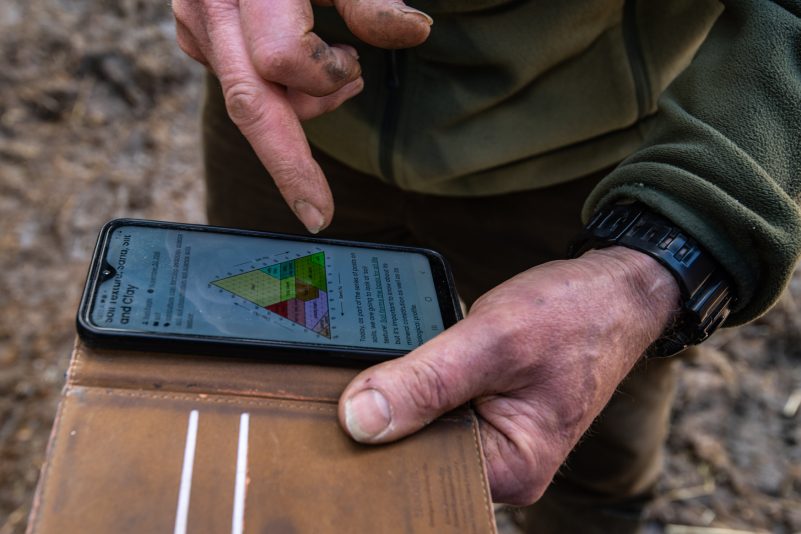Soils Data and the Land Use Framework for England Workshop Report

Introduction
The Soil Health and Carbon Dynamic Topic Advisory Group (Soils TAG) held an expert workshop to contribute information to the development of the Land Use Framework for England (LUF) and general understanding of soils’ place in it. The workshop heard from experts working with soil data, apps and toolkits, maps and mapping tools, and datasets. It featured ten speakers from a broad range of industries, including academia, industry supporting agriculture, third sector, and arm’s length bodies. The following summary provides an overview of the workshop and an outline of the key themes which were discussed.
Focus was placed on the intersection of soils data and the LUF, with discussion on the need for robust, accessible, and policy-relevant soil data to inform land use decisions. This session builds on previous discussions and workshops, reflecting the UK’s broader commitment to evidence-based policy in land management, agriculture, and climate mitigation. The event highlighted current gaps, challenges, and potential solutions regarding soil data collection, accessibility, and integration into land-use decision-making.
The Soils TAG co-leads introduced the workshop and the LUF consultation process, and workshop contributors were invited to present their respective soil datasets, maps, toolkits, or projects, and to share their observations and experiences on the following four questions:
- What kind of soils data (health and type) do you use / generate, at what resolution?
- Who ‘owns’ this data, and how available is it (public or private)?
- How do you apply / present it (maps, apps, portals etc)?
- What decision-making does it enable, and by whom?
These presentations were followed by a guided discussion around the question ‘How can Government unlock soils data for improved decision-making?’. The participants then examined Questions 17 – 20 from the LUF consultation (Annex 1) as a group, the workshop was concluded with observations and next steps from the Soils TAG co-leads.
Workshop aims and objectives
- To agree a framework of key enabling conditions
- To harvest success stories and identify common factors/levers/principles
- To identify gaps in the evidence and priorities for research
The Soils TAG are extremely grateful for the expert contributions and perspectives that were provided by the workshop participants:
- Professor Steve Hallett – LandIS, Cranfield University
- Dr. Matt Aitkenhead – James Hutton Institute
- Dave Nicholson – Agricarbon
- Crispin Hambridge – Environment Agency
- Tim Hopkin – Land App
- Tom Scrope – Soil Benchmark
- Graeme Willis – CPRE, the Countryside Charity
Key Themes and Discussion
The Importance of Soils Data in the Land Use Framework
Despite its critical importance, soil health has historically been undervalued in land-use planning. Participants agreed that the LUF presents an opportunity to integrate soil considerations more effectively into decision-making at local, regional, and national levels. Key discussion points which arose included:
- The need for data-driven land management – With increasing policy commitments around net zero, nature recovery, and food security, there is growing pressure to ensure land-use decisions are underpinned by robust soil data.
- The challenge of mainstreaming soils within the LUF – While soil plays a vital role in multiple environmental processes, workshop participants noted that it remains less visible in policy discussions compared to other land-use factors, such as forestry or urban development.
- A long-term vision for soil monitoring – Developing an approach to soil data collection that is consistent, long-term, and capable of informing policy was seen as essential.
Challenges in Soils Data Collection and Use
Despite the wealth of existing soil data, several barriers to effective use were identified:
Fragmentation and accessibility
- Soil data is scattered across multiple organisations, including government agencies, research institutions, and private landowners.
- There is no single authoritative database that compiles and standardises this information for easy access. Some datasets remain behind paywalls or restricted access, limiting their use by policymakers, researchers and innovators, NGOs, and land managers.
- Some participants suggested opening-up and simplifying data-sharing agreements in order to make soil data more available for practical use.
Inconsistencies in methodology
- Variations in sampling techniques, classification systems, and measurement standards make it difficult to compare soil data across different studies and regions.
- A lack of standards and a lack of adherence to national standardisation means soil datasets are often incompatible or difficult to integrate into broader land-use assessments.
Data gaps and spatial coverage issues
- Large land areas, particularly peatlands, grasslands, and marginal agricultural land, have limited soil monitoring data.
- There is a particular shortage of ongoing monitoring data on soil carbon stocks, biological activity, and degradation risks – nationally or regionally.
- Some participants suggested that farmers could play a greater role in data collection if incentivised appropriately.
- It was also suggested that on-the-ground soil monitoring should be expanded to cover underrepresented regions and land use types.
Harmonisation and the Need for a Coordinated Approach
A recurring theme throughout the workshop was the need for better harmonisation and coordination across the soil data landscape. While various organisations are conducting important work, a lack of coherence between datasets and methodologies reduces their overall effectiveness.
- A unified framework for soil data collection was proposed to ensure consistency and interoperability across different datasets.
- Participants discussed the potential for a centralised national soil data platform, where different stakeholders could access and contribute to a shared national repository that consolidates soil data from various sources into an accessible, user-friendly platform.
- The Environment Agency’s ALERT tool was discussed as a potential route for delivering these data.
- There was also strong interest in international best practices, with examples cited from countries that have successfully implemented large-scale soil monitoring initiatives.
Policy Implications: Integrating Soil Data into Decision-Making
For soil data to be useful in shaping land-use policies, it must be translated into practical, decision-support tools. Currently, much of the existing soil data is scientifically complex and not easily accessible for land managers or policymakers. Some participants observed that strengthening partnerships between government, academia, industry, and land users would ensure that soil data serves multiple purposes effectively.
Making soil data policy-relevant
- There was a clear call for better communication of soil data in a way that is actionable for policymakers.
- This includes developing soil health indicators that can be incorporated into land-use planning frameworks.
- Some participants also highlighted translating raw data into decision-support tools tailored for farmers, policymakers, and businesses as an effective way to make soil data policy-relevant and practically applicable.
Incentivising better soil data collection
- Farmers and landowners are well-positioned to provide on-the-ground localised data, but incentives are needed to encourage participation in wider schemes.
- Workshop attendees highlighted the potential role of agri-environment schemes in supporting better soil monitoring at the farm level.
Linking soil data to other environmental datasets
- Soil health does not exist in isolation; it interacts with climate, biodiversity, water management, and land productivity.
- A more integrated approach to environmental data collection could provide a fuller picture of land-use impacts and opportunities.
Technological Innovations in Soil Data Collection
Advances in technology are opening up new possibilities for soil monitoring. The workshop explored how emerging tools could help bridge data gaps and improve the accuracy of soil assessments. Participants discussed whether leveraging soil data collection and analysis technology, including AI, remote sensing, and digital platforms, could improve real-time soil analysis.
Remote sensing and satellite data
- Satellites and aerial surveys offer potential for large-scale soil monitoring, particularly in remote areas. However, ground-truthing remains essential to verify satellite-derived estimates.
- Full benefit should be made of existing national and regional surveys.
- AI and machine learning can help to interpret complex soil datasets, identifying trends and patterns that may not be visible through traditional analysis.
- There was discussion around the potential for AI-driven predictive modelling, which could forecast soil degradation risks and carbon sequestration potential.
- LIDAR technology was discussed, with participants agreeing that it represents an important dataset for monitoring various aspects relating to soil.
Farmer-led and citizen science approaches
- Some participants highlighted low-cost sensors and mobile apps as ways to empower farmers to collect and share soil data. Other incentive schemes should be encouraged to enable citizen science. Further national debate is required on this theme.
- While these approaches have promise, concerns were raised about data reliability, harmonisation, and standardisation, and the need for quality control mechanisms.
Conclusion
The Soils TAG’s Soil Data and the Land Use Framework for England workshop highlighted the critical importance of soil data in shaping England’s land-use strategies. While progress has been made towards effectively integrating soil data into land use decision making, workshop participants identified significant challenges in data standardisation, accessibility, and policy integration. In order to address these challenges, participants identified the importance of collaboration and innovation in unlocking the full potential of soil data for sustainable land management.
This workshop underscored the urgency of improving soil data infrastructure to meet the UK’s climate, biodiversity, and agricultural goals. Stakeholders concluded that a more coordinated, harmonised, and accessible approach to soil data collection and use will be vital for evidence-based land use decision making in the coming years.

Ellen Fay
Soil Health and Carbon Dynamics

Professor Pete Smith
Soil Health and Carbon Dynamics

Matthew Orman
Communications
Click here to access the PDF version of the workshop report
Click here to read the full workshop report appendix
Click here to watch the full workshop recording
Click here to access the workshop presentation slides
Subscribe to our Newsletter
A quarterly update of all LUNZ Hub activities, events and news stories.
